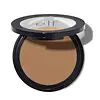What's inside
What's inside
 Key Ingredients
Key Ingredients

 Benefits
Benefits

 Concerns
Concerns

 Ingredients Side-by-side
Ingredients Side-by-side

Mica
Cosmetic ColorantSynthetic Fluorphlogopite
Magnesium Stearate
Cosmetic ColorantBoron Nitride
AbsorbentDimethicone
EmollientSilica
AbrasiveEthylhexyl Palmitate
EmollientCopernicia Cerifera Wax
Octyldodecyl Stearoyl Stearate
EmollientPhenoxyethanol
PreservativeTocopheryl Acetate
AntioxidantCaprylyl Glycol
EmollientSimmondsia Chinensis Seed Oil
EmollientBambusa Arundinacea Juice
AbrasiveButyrospermum Parkii Butter
Skin ConditioningIron Oxides
CI 77742
Cosmetic ColorantMica, Synthetic Fluorphlogopite, Magnesium Stearate, Boron Nitride, Dimethicone, Silica, Ethylhexyl Palmitate, Copernicia Cerifera Wax, Octyldodecyl Stearoyl Stearate, Phenoxyethanol, Tocopheryl Acetate, Caprylyl Glycol, Simmondsia Chinensis Seed Oil, Bambusa Arundinacea Juice, Butyrospermum Parkii Butter, Iron Oxides, CI 77742
Talc
AbrasiveMica
Cosmetic ColorantMagnesium Stearate
Cosmetic ColorantDimethicone
EmollientSilica
AbrasiveCaprylic/Capric Triglyceride
MaskingNylon-12
Ethylhexyl Palmitate
EmollientPhenoxyethanol
PreservativeParfum
MaskingButyl Methoxydibenzoylmethane
UV AbsorberEthylhexyl Methoxycinnamate
UV AbsorberDiethylhexyl Syringylidenemalonate
Skin ProtectingEthylhexylglycerin
Skin ConditioningBHT
AntioxidantCinnamyl Alcohol
PerfumingLimonene
PerfumingBenzyl Benzoate
AntimicrobialCI 77499
Cosmetic ColorantCI 77491
Cosmetic ColorantCI 15850
Cosmetic ColorantCI 77492
Cosmetic ColorantTalc, Mica, Magnesium Stearate, Dimethicone, Silica, Caprylic/Capric Triglyceride, Nylon-12, Ethylhexyl Palmitate, Phenoxyethanol, Parfum, Butyl Methoxydibenzoylmethane, Ethylhexyl Methoxycinnamate, Diethylhexyl Syringylidenemalonate, Ethylhexylglycerin, BHT, Cinnamyl Alcohol, Limonene, Benzyl Benzoate, CI 77499, CI 77491, CI 15850, CI 77492
Ingredients Explained
These ingredients are found in both products.
Ingredients higher up in an ingredient list are typically present in a larger amount.
Dimethicone is a type of synthetic silicone created from natural materials such as quartz.
What it does:
Dimethicone comes in different viscosities:
Depending on the viscosity, dimethicone has different properties.
Ingredients lists don't always show which type is used, so we recommend reaching out to the brand if you have questions about the viscosity.
This ingredient is unlikely to cause irritation because it does not get absorbed into skin. However, people with silicone allergies should be careful about using this ingredient.
Note: Dimethicone may contribute to pilling. This is because it is not oil or water soluble, so pilling may occur when layered with products. When mixed with heavy oils in a formula, the outcome is also quite greasy.
Learn more about DimethiconeEthylhexyl Palmitate, also known as octyl palmitate, is created from 2-ethylhexyl alcohol and palmitic acid. It is a fatty acid ester.
The fatty acid content of Ethylhexyl Palmitate makes it an emollient. Emollients help soften and hydrate your skin by trapping moisture within.
Ethylhexyl Palmitate is also used to help improve the texture of cosmetics. It helps other ingredient dissolve in products and help disperse ingredients more evenly.
You'll likely find this ingredient in sunscreen, as it is often used to mix UV-blocking ingredients such as avobenzone and ethylhexyl triazone.
It can also help stabilize the fragrances in a product as a fragrance fixative.
Ethylhexyl Palmitate can be used to substitute mineral oil.
Due to its high fatty acid content, it may not be fungal-acne safe.
Learn more about Ethylhexyl PalmitateMagnesium Stearate is a salt that is 2 parts stearic acid and 1 part magnesium.
It is a white powder that can be used to add bulk and color to products by binding to oil ingredients.
Mica is a naturally occurring mineral used to add shimmer and color in cosmetics. It can also help improve the texture of a product or give it an opaque, white/silver color.
Serecite is the name for very fine but ragged grains of mica.
This ingredient is often coated with metal oxides like titanium dioxide. Trace amounts of heavy metals may be found in mica, but these metals are not harmful in our personal products.
Mica has been used since prehistoric times throughout the world. Ancient Egyptian, Indian, Greek, Roman, Aztec, and Chinese civilizations have used mica.
Learn more about MicaPhenoxyethanol is a preservative that has germicide, antimicrobial, and aromatic properties. Studies show that phenoxyethanol can prevent microbial growth. By itself, it has a scent that is similar to that of a rose.
It's often used in formulations along with Caprylyl Glycol to preserve the shelf life of products.
Silica, also known as silicon dioxide, is a naturally occurring mineral. It is used as a fine, spherical, and porous powder in cosmetics.
Though it has exfoliant properties, the function of silica varies depending on the product.
The unique structure of silica enhances the spreadability and adds smoothness, making it a great texture enhancer.
It is also used as an active carrier, emulsifier, and mattifier due to its ability to absorb excess oil.
In some products, tiny microneedles called spicules are made from silica or hydrolyzed sponge. When you rub them in, they lightly polish away dead skin layers and enhance the penetration of active ingredients.
Learn more about Silica